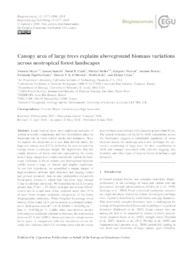Canopy area of large trees explains aboveground biomass variations across neotropical forest landscapes.
Canopy area of large trees explains aboveground biomass variations across neotropical forest landscapes.
Resumo: Large tropical trees store significant amounts of carbon in woody components and their distribution plays an important role in forest carbon stocks and dynamics. Here, we explore the Properties of a new lidar-derived index, the large tree canopy area (LCA) defined as the area occupied by canopy above a reference height. We hypothesize that this simple measure of forest structure representing the crown area of large canopy trees could consistently explain the landscape variations in forest volume and aboveground biomass (AGB) across a range of climate and edaphic conditions. To test this hypothesis, we assembled a unique dataset of high-resolution airborne light detection and ranging (lidar) and ground inventory data in nine undisturbed old-growth Neotropical forests, of which four had plots large enough (1 ha) to calibrate our model.We found that the LCA for trees greater than 27m (~25?30 m) in height and at least 100m2 crown size in a unit area (1 ha), explains more than 75% of total forest volume variations, irrespective of the forest biogeographic conditions. When weighted by average wood density of the stand, LCA can be used as an unbiased estimator of AGB across sites (R2=0.78, RMSE=46.02Mgha-1, bias=-0.63Mgha-1). Unlike other lidar-derived metrics with complex nonlinear relations to biomass, the relationship between LCA and AGB is linear and remains unique across forest types. A comparison with tree inventories across the study sites indicates that LCA correlates best with the crown area (or basal area) of trees with diameter greater than 50 cm. The spatial invariance of the LCA?AGB relationship across the Neotropics suggests a remarkable regularity of forest structure across the landscape and a new technique for systematic monitoring of large trees for their contribution to AGB and changes associated with selective logging, tree mortality and other types of tropical forest disturbance and dynamics.
Ano de publicação: 2018
Tipo de publicação: Artigo de periódico
Unidade: Embrapa Acre
Palavras-chave: Aboveground biomass, Biomassa aérea, Bosques neotropicales, Carbon sinks, Carbono, Cubierta forestal, Dossel, Estoque, Floresta neotropical, Forest canopy, Forest inventory, Inventario forestal, Inventário Florestal, Lasers, Lidar, Neotropical forests, Old-grow lowland, Planicies antiguas, Planícies antigas, Raio Laser, Remote sensing, Reservorios de carbono, Sensoriamento Remoto, Teledetección
Observações
1 - Por padrão são exibidas publicações dos últimos 20 anos. Para encontrar publicações mais antigas, configure o filtro ano de publicação, colocando o ano a partir do qual você deseja encontrar publicações. O filtro está na coluna da esquerda na busca acima.
2 - Para ler algumas publicações da Embrapa (apenas as que estão em formato ePub), é necessário ter, no celular ou computador, um desses softwares gratuitos. Sistemas Android: Google Play Livros; IOS: iBooks; Windows e Linux: software Calibre.
Acesse outras publicações
Acesse a Base de Dados da Pesquisa Agropecuária (BDPA) para consultar o acervo completo das bibliotecas da Embrapa.

